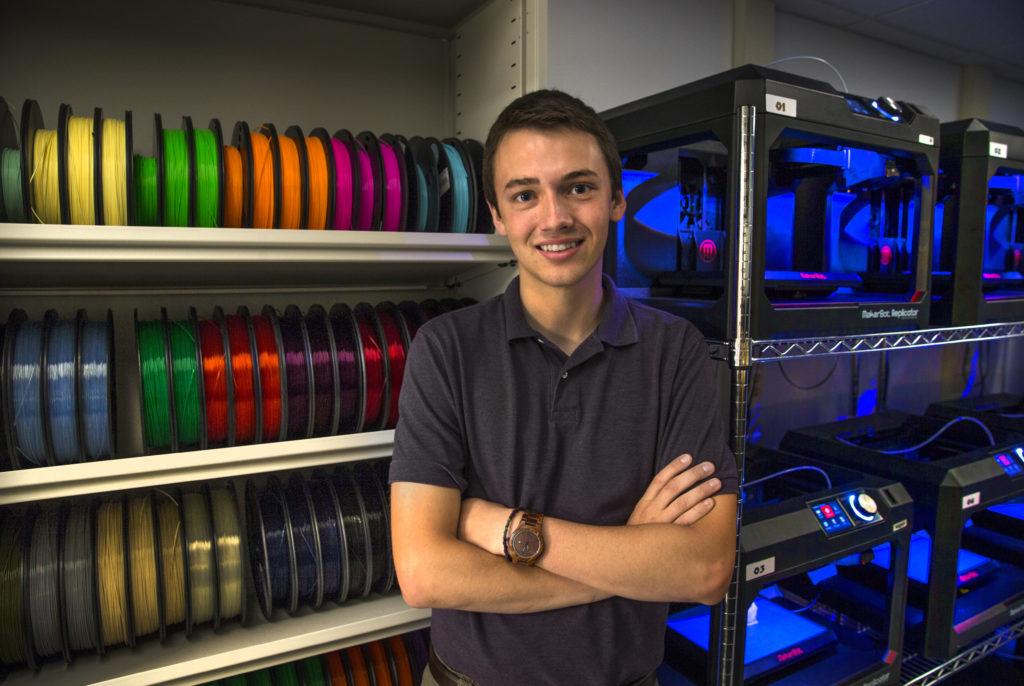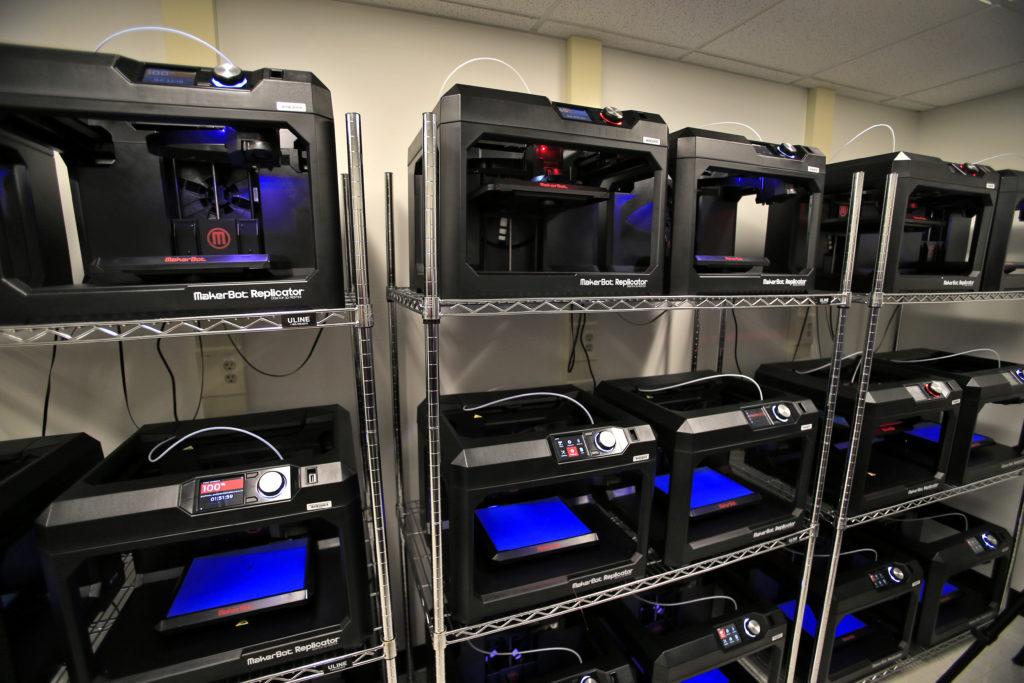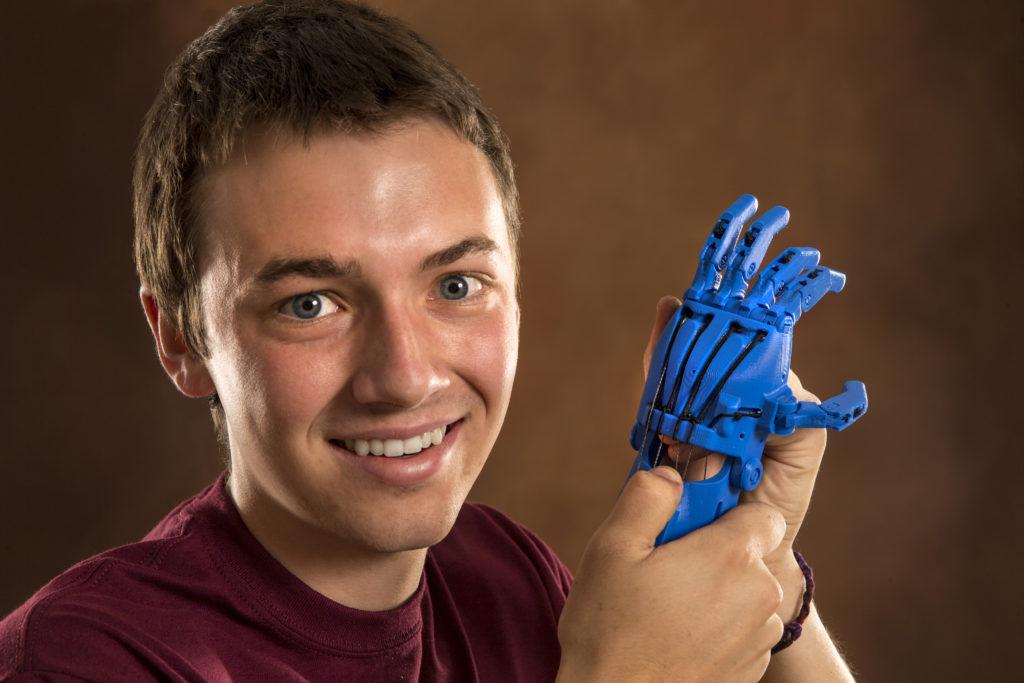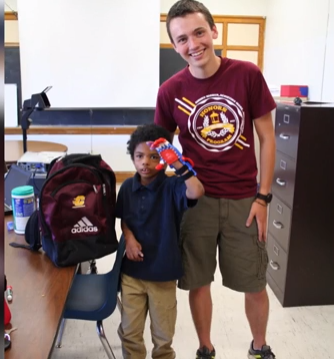Eight-Year-Old Michigan Boy with Moebius Syndrome Receives 3D Printed Hand from CMU’s MakerBot Innovation Center

Central Michigan University sophomore Austin Brittain engineered a Captain America-themed prosthetic hand for a Muskegon Heights boy with the help of CMU’s MakerBot Innovation Center.
Austin Brittain is a sophomore at Central Michigan University. And it goes to show that you never know what’s going to happen when you walk into class on any given day, as recently Brittain’s entrance was marked by his professor asking if he might like to work with one of the other departments to create a 3D printed prosthetic for a boy born without a hand. Not missing a beat, Brittain was up to the challenge, and ready to put their on-site 3D printing technology to the test.
Michael Bell is eight years old. He lives in Muskegon Heights and was born without his left hand, due to a condition referred to as Moebius Syndrome. A nonprogressive craniofacial/neurological disorder, numerous issues can accompany this syndrome, from facial paralysis to respiratory and speech problems, as well as nerve problems. Limb abnormalities often arise as well, as in Michael’s case.
Although Michael attends school, his resource room teacher was beginning to notice that he was struggling in class and she thought he could use some additional help with a prosthetic. A CMU alumna herself, Sarah Volker’s husband works at the university—and as she began examining the possibilities of 3D printed prosthetics, she discussed the potential with her husband Michael Volker and Greg Stahly—both CMU art and design faculty members.

Central Michigan University is the first public university in the Midwest with a MakerBot Innovation Center, a large-scale 3D printing installation, and one of few in the United States to house an Innovation Center that focuses on arts and human services. [Photo by Steve Jessmore/Central Michigan University]
“It was eye-opening for me because I’m a 2D person, and it was fun to learn the process and watch the whole thing develop,” said Volker.
“It gave us an opportunity to show what the 3D printers can do for real people, not just to study. I think it would also be good for people who are interested in studying here, at CMU and in the art department, to see the kind of world that the 3D printer can open up.”
Brittain has been a fan of 3D printing since learning of the technology and consequently signing up for a 3D creation course at Central Michigan University, where they are lucky to have a MakerBot Innovation Center—one that we reported on last year as it was set up in Wightman Hall, offering one of the only lab setups of its kind in the Midwest, as far as public learning institutions go.
“Ever since hearing that you could 3D print prosthetic hands, I was blown away by that application,” said Brittain, a mechanical engineering and technology student. “To be able to actually do that was really an amazing moment for me.”

“This was a sort of test hand,” said Austin Brittain, a Central Michigan University student from Breckenridge, Michigan. “It is the Raptor Reloaded design from Enabling the Future. Assembling it gave me an understanding of how these devices work, which came in handy when I was putting Michael’s hand together. Michael’s device is the Phoenix hand, which is a newer design.” [Central Michigan University photo by Steve Jessmore]
 In Michael’s case, Brittain chose to 3D print a red, white, and blue prosthetic upon discovering that the little boy is a big fan of Captain America. The hand itself used less than $10 in plastic, and the project overall ending up costing less than $100. Considering that traditional prosthetics cost into the thousands, require many inconvenient fittings, and are not nearly as customized, this new trend in 3D printing medical devices is certain allowing for much more accessibility.
In Michael’s case, Brittain chose to 3D print a red, white, and blue prosthetic upon discovering that the little boy is a big fan of Captain America. The hand itself used less than $10 in plastic, and the project overall ending up costing less than $100. Considering that traditional prosthetics cost into the thousands, require many inconvenient fittings, and are not nearly as customized, this new trend in 3D printing medical devices is certain allowing for much more accessibility.
Consisting of the wrist gauntlet, palm piece, and fingers, the design is held together with hinges and strings that are responsible for flexibility and movement, allowing the fingers to close when the wrist flexes, and for the fingers to open when pressure is released. Brittain was able to take the hand to Michael on his last day of the school year, with quite a crowd there to celebrate including Michael’s mom, all of his classmates, the school superintendent, and the special education director.
“He felt like a superhero, and that’s really cool for him because he wasn’t exactly in a position to feel like that every day,” Brittain said.
“Fully assembled, ready to go, and Michael’s family didn’t have to pay for any of that,” Brittain said. “That was really powerful for them and shows what the university is capable of doing with their resources, as far as helping people out.”
The outcome has been extremely positive as most importantly, Michael’s new arm is functioning very well upon later reports, but also in that this project shows the true potential for the CMU 3D printing lab.
Everyone plans to stay in touch, and Brittain has already been thinking ahead to when Michael will outgrow this prosthetic, giving the child’s mother resources for easy replacement parts. Discuss this inspiring story further in the 3D Printed Prosthetic Hand forum over at 3DPB.com.
[Source / Images: Supplied Directly from Central Michigan University]Subscribe to Our Email Newsletter
Stay up-to-date on all the latest news from the 3D printing industry and receive information and offers from third party vendors.
Print Services
Upload your 3D Models and get them printed quickly and efficiently.
You May Also Like
Reinventing Reindustrialization: Why NAVWAR Project Manager Spencer Koroly Invented a Made-in-America 3D Printer
It has become virtually impossible to regularly follow additive manufacturing (AM) industry news and not stumble across the term “defense industrial base” (DIB), a concept encompassing all the many diverse...
Inside The Barnes Global Advisors’ Vision for a Stronger AM Ecosystem
As additive manufacturing (AM) continues to revolutionize the industrial landscape, Pittsburgh-based consultancy The Barnes Global Advisors (TBGA) is helping shape what that future looks like. As the largest independent AM...
Ruggedized: How USMC Innovation Officer Matt Pine Navigates 3D Printing in the Military
Disclaimer: Matt Pine’s views are not the views of the Department of Defense nor the U.S. Marine Corps Throughout this decade thus far, the military’s adoption of additive manufacturing (AM)...
U.S. Congress Calls Out 3D Printing in Proposal for Commercial Reserve Manufacturing Network
Last week, the U.S. House of Representatives’ Appropriations Committee moved the FY 2026 defense bill forward to the House floor. Included in the legislation is a $131 million proposal for...

































